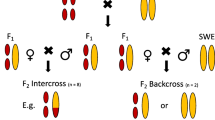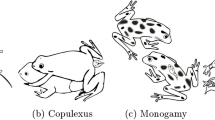Abstract
The pattern of inheritance indicates that the gene for aconitase-1 is sex linked in the frog, Rana clamitans, and that the male is the heterogametic sex. Unlike mammals, both male and female frogs carry and express two alleles for this sex-linked gene. Therefore, the sex chromosomes in these frogs and probably others behave like an autosomal pair, with one homologue carrying a male-determining element.
Similar content being viewed by others
References
Baverstock, P. R., Adams, M., Polkinghorne, R. W., and Gelder, M. (1982). A sex-linked enzyme in birds—Z-chromosome conservation but no dosage compensation. Nature 296763.
DiBerardino, M. A. (1967). Frogs. In Wilt, F. H., and Wessells, N. K. (eds.), Methods in Developmental Biology T. Y. Crowell, New York, p. 53.
Elinson, R. P. (1977). Amphibian hybrids: A genetic approach to the analysis of their developmental arrest. Differentiation 93.
Elinson, R. P. (1981). Genetic analysis of developmental arrest in an amphibian hybrid (Rana catesbeiana, Rana clamitans). Dev. Biol. 81167.
Ferrier, V., Jaylet, A., Cayrol, C., Gasser, F., and Buisan, J. J. (1980). Étude électrophorétique des peptidases érythrocytaires chez Pleurodeles waltlii (Amphibien Urodèle): Mise en évidence d'une liaison avec le sexe. C. R. Acad. Sci. Paris Ser. D 290571.
Iturra C., P., and Veloso M., A. (1981). Evidence for heteromorphic sex chromosomes in male amphibians (Anura: Leptodactylidae). Cytogenet. Cell Genet. 31108.
Kawamura, T., and Nishioka, M. (1977). Aspects of reproductive biology of Japanese anurans. In Taylor, D. H., and Guttman, S. I. (eds)., The Reproductive Biology of Amphibians Plenum, New York, p. 103.
Mengden, G. A. (1981). Linear differentiation of the C-band pattern of the W chromosome in snakes and birds. Chromosoma 83275.
Mikamo, K., and Witschi, E. (1964). Masculinization and breeding of the WW Xenopus. Experientia 20622.
Nishioka, M., and Ueda, K. (1976). Sex reversal and existence of YY males in Hyla arborea japonica. Jap. J. Genet. 51429.
Ohno, S. (1967). Sex Chromosomes and Sex-Linked Genes. Springer-Verlag, New York.
Richards, C. M., and Nace, G. W. (1978). Gynogenetic and hormonal sex reversal used in tests of the XX-XY hypothesis of sex determination in Rana pipiens. Growth 42319.
Schempp, W., and Schmid, M. (1981). Chromosome banding in amphibia. VI BrdU-replication patterns in Anura and demonstration of XX/XY set chromosomes in Rana esculenta. Chromosoma 83697.
Schmid, M. (1978a). Chromosome banding in amphibia. I. Constitutive heterochromatin and nucleolus organizer regions in Bufo and Hyla. Chromosoma 66361.
Schmid, M. (1978b). Chromosome banding in amphibia. II. Constitutive heterochomatin and nucleolus organizer regions in Ranidae, Microhylidae and Rhacophoridae. Chromosoma 68131.
Schmid, M. (1980a). Chromosome banding in amphibia. IV. Differentiation of GC-and AT-rich chromosome regions in Anura. Chromosoma 7783.
Schmid, M. (1980b). Chromosome banding in amphibia. V. Highly differentiated ZW/ZZ sex chromosomes and exceptional genome size in Pyxicephalus adspersus (Anura, Ranidae). Chromosoma 8069.
Siciliano, M. J., and Shaw, C. R. (1976). Separation and localization of enzymes on gels. In Smith, I. (ed.), Chromatographic and Electrophoretic Techniques, Vol. 2 4th ed., William Heinemann, London, p. 184.
Swingle, W. W. (1926). The germ cells of anurans. II. An embryological study of sex differentiation in Rana catesbeiana. J. Morphol. 41441.
Tymkowska, J. (1977). A comparative study of the karyotypes of eight Xenopus species and subspecies possessing a 36-chromosome complement. Cytogenet. Cell Genet. 18165.
Wachtel, S. S., Koo, G. C., and Boyse, E. A. (1975). Evolutionary conservation of H-Y (male) antigen. Nature 254270.
Wright, D. A., and Richards, C. M. (1983). Two sex-linked loci in the leopard frog, Rana pipiens. Genetics 103249.
Wright, D. A., Richards, C. M., and Nace, G. W. (1980). Inheritance of enzymes and blood proteins in the leopard frog, Rana pipiens: Three linkage groups established. Biochem. Genet. 18591.
Zaborski, P. (1979). Sur la constance de l'expression de l'antigène H-Y chez le sexe hétérogamétique de quelques Amphibiens et sur la mise en évidence d'un dimorphisme sexual de l'expression de cet antigène chez l'Amphibien Anoure Pelodytes punctatus D. C. R. Acad. Sci. Paris Ser. D 289:1153.
Author information
Authors and Affiliations
Additional information
This work was supported by a grant from NSERC, Canada.
Rights and permissions
About this article
Cite this article
Elinson, R.P. Inheritance and expression of a sex-linked enzyme in the frog, Rana clamitans . Biochem Genet 21, 435–442 (1983). https://doi.org/10.1007/BF00484436
Received:
Revised:
Issue Date:
DOI: https://doi.org/10.1007/BF00484436




